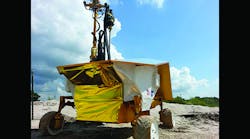After years of testing, NASA’s excavating autonomous robot, the Resource Prospector, now appears equipped to investigate the availability of water and other elements on the moon. If authorized, NASA will launch the robot to the moon in 2020.
The initiative builds on the Lunar Crater Observation and Sensing Satellite (LCROSS) and the Lunar Reconnaissance Orbiter (LRO) missions, both of which were successful in finding water on the moon. NASA has been testing the Resource Prospector in simulated environments on earth to develop its ability for analyzing, harvesting, and processing natural elements from underground.
The robot contains a drill unit, suspended wheels for covering rocky terrain, and a neutron-spectrometer tool that can determine the quality and quantity of atoms and isotopes in volatiles such as hydrogen, nitrogen, helium, methane, ammonia, hydrogen sulfide, carbon monoxide, carbon dioxide, sulfur dioxide, and water.
Watch a virtual demonstration of the Research Prospector's landing and mission goals.
NASA hopes that the elements can be harvested for future shipment to extraterrestrial human colonies and missions. Not only will these elements help sustain life, but they will also be key ingredients in developing fuel and materials. Utilizing resources directly from the moon, and eventually other planets and asteroids, could ultimately lead to decreased the weight of payloads, saving thousands of dollars in attempts to colonize our solar system.



